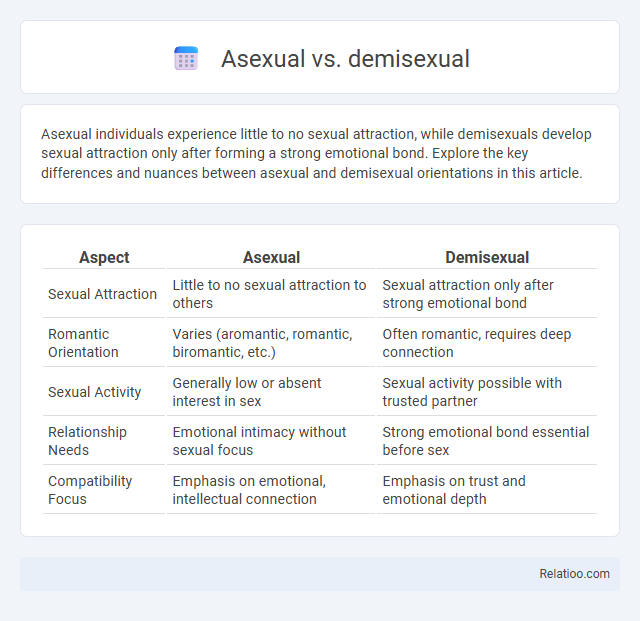Asexual individuals experience little to no sexual attraction, while demisexuals develop sexual attraction only after forming a strong emotional bond. Explore the key differences and nuances between asexual and demisexual orientations in this article.
Table of Comparison
| Aspect | Asexual | Demisexual |
|---|---|---|
| Sexual Attraction | Little to no sexual attraction to others | Sexual attraction only after strong emotional bond |
| Romantic Orientation | Varies (aromantic, romantic, biromantic, etc.) | Often romantic, requires deep connection |
| Sexual Activity | Generally low or absent interest in sex | Sexual activity possible with trusted partner |
| Relationship Needs | Emotional intimacy without sexual focus | Strong emotional bond essential before sex |
| Compatibility Focus | Emphasis on emotional, intellectual connection | Emphasis on trust and emotional depth |
Understanding Asexuality: Definition and Spectrum
Asexuality is a sexual orientation characterized by a lack of sexual attraction to others, existing on a spectrum from complete absence of sexual desire to occasional or situational experiences. Demisexual individuals require a strong emotional connection before experiencing sexual attraction, distinguishing them from both asexual and sexual orientations. Understanding this spectrum highlights that asexuality is not a monolith but encompasses diverse experiences and degrees of attraction.
Demisexuality Explained: Key Characteristics
Demisexuality is a sexual orientation where individuals experience sexual attraction only after forming a strong emotional bond, differing from sexual orientation defined by immediate attraction. Unlike asexual individuals who typically do not experience sexual attraction, demisexuals may have sexual desires tied to emotional closeness, making this orientation unique in the spectrum. Understanding demisexuality helps you recognize the varied ways people experience attraction beyond the traditional categories of asexual and sexual orientations.
Core Differences Between Asexual and Demisexual Identities
Asexuality is characterized by a lack of sexual attraction to others, whereas demisexuality involves experiencing sexual attraction only after forming a strong emotional bond. Your understanding of these orientations hinges on recognizing that asexual individuals generally do not feel sexual desire, while demisexual individuals may experience it under specific circumstances. These core differences shape how people navigate relationships and personal identity within the spectrum of sexual orientations.
Emotional Attraction vs Sexual Attraction
Asexual orientation is characterized by a lack of sexual attraction to others, while demisexual individuals experience sexual attraction only after forming a strong emotional connection. Sexual orientation encompasses a broader spectrum, involving both emotional attraction and sexual attraction, with varying degrees of intensity depending on the individual. Understanding the distinction between emotional attraction, which involves deep feelings of closeness and affection, and sexual attraction, centered on physical desire, is key to recognizing the differences among asexual, demisexual, and sexual orientations.
Common Myths About Asexual and Demisexual People
Common myths about asexual and demisexual people often misunderstand their experiences, falsely claiming asexual individuals lack the capacity for romantic relationships or that demisexuality is just selective attraction rather than a valid orientation. You may encounter misconceptions that asexuality means celibacy or that demisexual people choose to feel attraction only after forming emotional bonds. Scientific research and personal testimonies clarify that both orientations are distinct and valid identities within the broader spectrum of sexual orientations.
Navigating Relationships as Asexual or Demisexual
Navigating relationships as asexual or demisexual involves understanding unique emotional and physical connection needs, where asexual individuals may experience little to no sexual attraction, and demisexual individuals develop sexual attraction based on deep emotional bonds. Clear communication about boundaries, desires, and expectations is essential to building trust and intimacy that align with each orientation. Recognizing and respecting these orientations fosters healthy relationships that prioritize consent and emotional fulfillment over traditional sexual norms.
Language and Labels: Self-Identification Matters
Language and labels shape how individuals understand and express their sexual orientation, with terms like asexual, demisexual, and sexual providing distinct frameworks for identity. Self-identification matters because it allows you to define your experiences and attractions authentically, promoting respect and visibility within diverse communities. Using accurate terminology fosters clearer communication and supports personal empowerment in navigating complex emotional and romantic landscapes.
Representation in Media and Popular Culture
Representation of asexual, demisexual, and sexual orientations in media and popular culture remains uneven, with sexual orientation frequently dominating portrayals. Asexual and demisexual identities often experience underrepresentation or are mischaracterized, leading to a lack of visibility that affects public understanding and acceptance. Your awareness of these nuanced orientations can promote more inclusive storytelling and foster better representation across diverse media platforms.
Overlapping Experiences: Points of Intersection
Asexual, demisexual, and sexual orientations share overlapping experiences centered on emotional connection, attraction, and intimacy, with each orientation navigating these aspects uniquely. You may find that demisexuality intersects with both asexuality and sexual orientation through its emphasis on forming a deep emotional bond before experiencing sexual attraction. Understanding these points of intersection highlights the nuanced spectrum of human attraction and challenges rigid labels within the LGBTQ+ community.
Creating Inclusive Spaces for All Sexual Orientations
Creating inclusive spaces requires recognizing the unique experiences of asexual, demisexual, and sexual orientations to ensure that everyone feels validated and respected. Emphasizing education on the distinctions--such as asexuality's lack of sexual attraction, demisexuality's conditional attraction based on emotional bonds, and sexual orientation's varied preferences--promotes empathy and understanding. Inclusive environments foster mental well-being and social equity by integrating pronoun respect, diverse relationship norms, and intersectional support systems tailored to all sexual orientations.

Infographic: Asexual vs Demisexual
 relatioo.com
relatioo.com